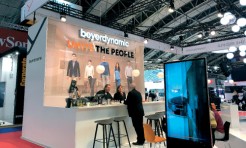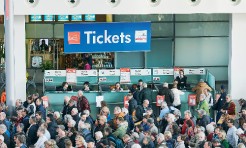Germany: Feel-good factor for fairs
A global survey by UFI and Explori among 13,000 trade fair visitors revealed that catering and seating are important factors. German trade fair companies agree.

Messe München refers to its own surveys and confirms the findings of the study. Both factors - seating and catering - are apparently important to visitors. “That is why we attach great importance to a high-quality food service,” says Klaus Dittrich. “Our guests can choose from a wide range of restaurants offering German and international specialities, snack bars and bistros,” explains the Chairman and CEO of Messe München. The exhibition centre in the Bavarian capital is spending quite a lot on this. “Two years ago we started a major investment programme in our F&B facilities,” says Dittrich. Plus: An in-house Gasto-Guide shows all the F&B offers at a glance.
And to do justice to “seating” as a feel-good factor, all catering facilities at Munich’s exhibition centre offer guests a chance to sit down. “Our spacious beer gardens in the heart of the exhibition centre - designed as particularly inviting places for lingering - are a great bonus in this respect,” says Klaus Dittrich. In addition, there are seating areas for in-show catering in the halls. In view of the good facilities there, seating and catering are rather secondary factors for the design of free spaces (www.messe-muenchen.de).

Messe Frankfurt offers 22 restaurants and 70 bistros and shops - with a variety of culinary specialities and plenty of seating options. “Our surveys show that food plays a major role for visitors,” confirms Iris Jeglitza-Moshage. “And quiet zones are also much appreciated,” adds the board member of Messe Frankfurt Exhibition. The even distribution of restaurants and bistros across the exhibition halls, in foyers and the outdoor area is an advantage, so visitors never need go far to take a break. Moreover, there are networking areas for many events with seating for relaxed discussions.
Depending on the event, Messe Frankfurt also integrates cafés into the floor plan as part of the exhibition concept. “At Ambiente 2020, designers will create eleven cafés exclusively for the fair,” Iris Jeglitza-Moshage cites an example. “Designed with exhibitor products, they are places for breaks, for refreshment and also for inspiration.” In general, the “feel-good factor” is key for trade fair visits. For new events in Frankfurt it is factored in right from the start. At Hypermotion, for example, “Eat & Talk Areas”, not only serve for catering but also as meeting points and event venues. This makes them the perfect setting for intensive talks between participants: “In this case, food and drinks are included in the ticket price” (www.messefrankfurt.com).

In the surveys, Messe Köln observed strong differences between individual trade fairs. They cannot confirm that food and seating are “sources of frustration” as discovered in the UFI/Explori study. “All in all, there is not much negative feedback,” explains Stefan Eckert. “Both for catering and the quiet zones," says the Vice President Services and member of the Executive Board of Koelnmesse. Seating areas in the hall play an active conceptual role in the layout of well-booked trade shows. On the other hand, they are more of a decorative element, for example to cover vacant areas. “We use the available free space to create communication zones by providing seats for visitors and exhibitors,” Eckert argues. “Including facilities for charging cell phones and laptops.”
In addition to stationary F&B facilities, variable outlets are set up in Cologne. They are tailored to “the event and number of visitors,” describes Stefan Eckert. “We provide mobile coffee bars, hot dog stands, pretzel trolleys, food courts and lounge areas with a variety of F&B offerings.” In the course of construction measures for the Koelnmesse 3.0 project, increasing demands of the visitors are to be taken more into account. As of this year, there will be more F&B offers: “From mobile stations through bistros, large self-service food areas to restaurants with a first-class service” (www.koelnmesse.de).

NürnbergMesse confirms that visitors express demand for more seating areas - and that the first and foremost task when allocating hall space is to position all exhibitors in the best possible way. If the hall does not have a fixed catering facility, which is rarely the case, those responsible will find a solution. “Then an extra catering zone is integrated in the layout plan,” says Thomas Koch. “If the exhibition area allows,” adds the head of corporate communications of NürnbergMesse, who is also a board member. “In general, we have found that al-fresco catering and dining make an excellent combination.” This is why NürnbergMesse often uses its centrally located exhibition park for this purpose. “But we have also installed a new Baguetteria as a quick-stop concept,” says Koch. “There we serve takeaway food and drink.”
As NürnbergMesse observes, event catering is becoming increasingly important for customers. “Today, it is a major factor that influences the visitor experience of an event,” observes Thomas Koch. This is mainly due to the higher expectations of exhibitors and visitors regarding the eventisation of trade fairs. “Food areas are increasingly becoming experience and feel-good zones,” claims Koch. “Our in-house catering department is adapting to these ever shorter trend cycles.” In other words, trade fair caterers focus increasingly on the respective target group of the event (www.nuernbergmesse.de).
Author: Peter Borstel
This article was published in TFI issue 1/2020
Share in Facebook, Twitter or Google+:
TFI - Trade Fairs International - The International Trade Fair Magazine.
© 2006 - 2024 by TFI-Verlagsgesellschaft mbH. All rights reserved. TFI-Verlagsgesellschaft mbH shall accept no responsibility for the contents of external links and other contents.
TFI-Know-how
-
What to do when things go wrong at virtual or in-person events?

In the event world, it’s simply part of life if things don’t work out as planned.
-
How can networking be made to work at online events?

Networking typically happens at real, in-person events. But it’s also possible to do it online; it just works a little differently. There are various options available to organisers.
-
How can exhibitors stand out at trade fairs?

New products and a well-conceived stand design are not the only drivers for a successful presence. Many other factors are also important, but trade fair planners often lose sight of them.
-
How can industry decision-makers be reached online?

Trade fairs and trade fair companies need to constantly further develop, become more agile and flexible and offer services all year round. New, digital offerings are very important here. With its TrustedTargeting technology, Messe München offers its customers access to leading business-to-business decision-makers on the Internet.


